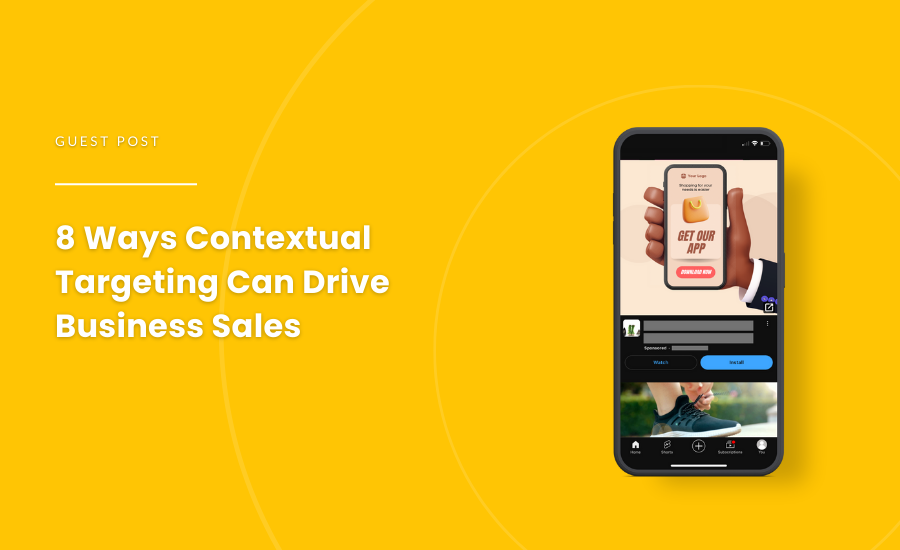In the old days, advertisers relied on placing advertisements in magazines and TV ad breaks to reach their audience, and contextual targeting was their bread and butter. Then, data-tracking and behavioral marketing led to these methods falling out of fashion. Now, with third-party data collection phasing out, this cookie-less kind of advertising is back in vogue.
Switching to less intrusive ways of targeting is a shift that all marketers must make. The good news is, with innovations in contextual targeting, this change is nothing to be afraid of. It can actually lead to a huge boost in audience engagement and business sales. Let’s find out how.
Jump to Section
- What Is Contextual Targeting?
- Why You Should Invest in Contextual Targeting
- 8 Ways to Use Contextual Targeting to Boost Business Sales
- 1. Ride the Keyword Wave With Contextual Precision
- 2. Master the Art of Topic Targeting
- 3. Leverage Behavioral Targeting
- 4. Embrace the Power of Dynamic Creative Optimization
- 5. Investigate New Platforms and Channels
- 6. Expand Into New Audiences and Communities
- 7. Conquer Geofencing
- 8. Contextual Retargeting
What Is Contextual Targeting?
Contextual marketing is a way of targeting ads based on the context in which they’ll be displayed. Crucially, it doesn’t rely on individual user data or behavioral analysis. Knowing where your ads appear has benefits for brand safety and suitability, too.
This involves analyzing the keywords or themes of the webpage or platform where the ad will show. You then tailor its content accordingly, as you would with behavioral marketing. Essentially, you segment ads based on marketing channels instead of customer behaviors.

Contextual Targeting vs. Behavioral Targeting
Contextual marketing and behavioral marketing are two distinct approaches to targeting audiences. Behavioral marketing focuses on user behaviors and past actions. Contextual marketing targets users based on the content they are currently consuming.
To the layman, this differentiation may seem semantic, but these strategies differ dramatically, as do their perceptions. Contextual targeting is perceived as a much less intrusive way of reaching audiences. That may be why contextual targeting averaged a 73% increase in performance compared to behavioral targeting.
Why You Should Invest in Contextual Targeting
Our recent times have been marked by growing privacy concerns, evolving regulations, and now the demise of third-party cookies. Unsurprisingly, contextual targeting is gaining a lot of attention. However, it’s not just a necessity that’s urging savvy marketers toward this pivot – let’s take a look at some reasons why investing in contextual targeting should be a no-brainer.
Navigating the Post-Cookie Era
Google has finally tightened regulations around data usage. Contextual marketing offers a now vital privacy-compliant alternative to behavioral marketing. There are still possibilities for behavioral targeting with sales automation in CRM systems. Nonetheless, many marketers are vying for this less intrusive option.
Leveraging contextual signals such as content themes and user context, marketers can deliver personalized experiences without compromising user privacy. This approach respects user preferences and, just as important, regulatory requirements.
Moreover, it also fosters brand trust and safety, which is essential in today’s market where authenticity and credibility are paramount. Utilizing professional mock ups tailored to each contextual placement ensures that your brand’s message resonates effectively with the audience.
Boosting Audience Engagement
Contextual targeting is based on the contexts that users are currently consuming. This ensures your message reaches its audience when they’re most engaged with what they’re viewing. This is why it can increase the likelihood of engagement compared to behavioral targeting.
Instead of relying on past behavior to predict the future, contextual targeting reaches the user in the context of their favorite websites, social media channels, podcasts, YouTube videos, and more.
When switching to contextual targeting, you may experience a huge boost in sales. For this reason, it’s a good idea to make sure your sales enablement software is up to date. This will help you track where your traffic is coming from and develop a sales playbook for each segment of your audience.
Future-Proofed Adaptability
Behavioral targeting has long been hailed as the holy grail of personalized marketing. Still, its reliance on past behaviors presents inherent limitations. Another shortcoming is that vast data sets of past behavior can skew the significance of current trends and events. This makes it very rigid and unadaptable as a targeting strategy.
Contextual targeting, on the other hand, operates in the present moment. It leverages real-time context to comprehend the present social climate and deliver timely, relevant messages.
This approach ensures that marketing efforts adapt to shifting consumer interests. So, it circumvents the pitfalls of outdated or inaccurate behavioral data: primarily, data drift.
Contextual targeting provides built-in drift monitoring for your marketing campaigns. As your marketing models deteriorate over time, you’ll get immediate feedback with contextual targeting as you can monitor the performance of each channel in real-time.
8 Ways to Use Contextual Targeting to Boost Business Sales
Gone are the days of scattershot demographic targeting and rudimentary interest-based approaches. Nowadays, contextual targeting employs a sophisticated, data-driven approach.
You can meticulously analyze real-time content and user behavior to deliver hyper-relevant advertisements, then multivariate tests to measure ad effectiveness. Intrigued? Let us delve into eight captivating strategies to wield this marketing magic.
Ride the Keyword Wave With Contextual Precision
Keywords are still important, valuable tools. Now though, understanding their contextual nuances is becoming increasingly integral to their effectiveness. Understanding not just the keywords your audience searches for, but why they’re searching for them makes a huge difference.
This ensures that ads are always relevant to the content being viewed. By understanding that the keywords you’re targeting can offer valuable insights into your audience, it can lead to exciting innovations in your placement strategy.
For instance, your hiking boots advertisement could just appear on “hiking boots” pages. However, by understanding search intent, you could also target an article detailing the conquest of Mount Everest, highlighting features mentioned in the text.
Master the Art of Topic Targeting
Move beyond individual keywords. Delve into the nitty gritty of topics and themes to craft effective content.
If you sell trainers, don’t just target “running shoes.” Explore niches like “minimalist running” or “ultramarathon training” too. This approach ensures your ad reaches users actively engaged in conversations. Moreover, as your content covers more niches of a topic, your brand will gain more authority.
On top of this, tailor your topic targeting to your purchase funnel and sales cycle. For example, if you’re an SaaS company focused on the enterprise software sales cycle, you’ll want to make sure that you consider different topics that align with your prospecting and your retargeting phases. Partnering with a SaaS content writing company can further enhance your strategy by creating tailored content that resonates with your target audience at every stage of the sales funnel.
Leverage Behavioral Targeting
This may seem to spit in the face of what we said earlier, but these two approaches can be used in harmony. Behavioral marketing doesn’t depend entirely on third-party cookies or cookie files. You can still use zero-party data to learn about how your users engage with content.
This granular data lets you target users based on specific interests and behavior. This means if you follow our earlier advice about sales enablement software, you can develop a comprehensive sales playbook with a cold call script for each customer segment.
Embrace the Power of Dynamic Creative Optimization
Don’t be a jarring billboard in a scenic landscape. Leverage the power of native advertising to seamlessly integrate your ads within relevant content, blending in like a chameleon. With the possibilities of generative AI, there is truly no excuse for monotonous marketing.
With AI creative engines, you can tailor every element in your ads, from your copy right down to your brand logo. This is a crucial part of ad placement. It’s not enough to get your ads in the right place and stick out like a sore thumb. You must adapt to the context of users’ engagement.
Investigate New Platforms and Channels
Don’t limit yourself to established channels or those you’ve used before. Experiment, explore, and identify high-traffic websites and platforms where your target audience spends their time.
Consider leveraging platforms that facilitate virtual communication, which has become more prevalent than ever, such as online forums, webinars, virtual events, and social media groups. These avenues provide unique opportunities to engage with your audience in real-time, fostering meaningful interactions and building stronger connections.
Expand Into New Audiences and Communities
The media landscape of the digital age is an ever-evolving hodgepodge of different mediums, channels, and platforms. It’s no place to fear change. One of the best things about contextual targeting is its versatility and its freedom.
Stay ahead of the curve by exploring emerging trends towards certain audiences and niche communities. Explore the possibilities of micro-influencers on social media, podcasts, and YouTube contextual targeting. Strategic placement targeting can significantly amplify your reach and drive qualified traffic to your business.
Conquer Geofencing
Geofencing is a location-based kind of contextual targeting. It involves creating virtual boundaries around specific locations, such as stores or events. When a user passes through these boundaries, they can receive targeted messages on their mobile devices, including short code text messages, which are concise, alphanumeric codes often used for marketing promotions or interactive campaigns.
Geofencing transcends the limitations of simply blasting ads at everyone within a mall. It empowers you to target users within specific, relevant locations at the perfect moment.

Contextual Retargeting
Website visitors are like butterflies – they flit in and out with ease. Don’t let them flutter away forever. Contextual retargeting allows you to re-engage users who have shown interest with ads relevant to pages of your website they visited in the past.
Using tools like Google tag manager, you can target users with ads that align with the content they have already interacted with. This helps to create a strong impression on audiences, creating a personalized experience that resonates with users.
Get on Board with Contextual Targeting
As we navigate the unknown territories of our post-cookie future, contextual targeting will become an important tool in the marketer’s arsenal.
Not only will it future-proof against further regulatory restrictions, it enables them to deliver more relevant and timely advertisements. All this results in increased engagement, higher conversion rates, and improved ROI from your marketing efforts. By embracing contextual strategies now, marketers can get ahead of the curve.
This article is a guest post. The guest author is solely responsible for ensuring the accuracy and authenticity of the information provided in the article. Any product or service recommendations or mentions made in the guest post are not endorsed by Strike Social.
For guest posting opportunities, we invite you to reach out to us. We are excited to collaborate with talented writers and feature high-quality content on our blogs.








